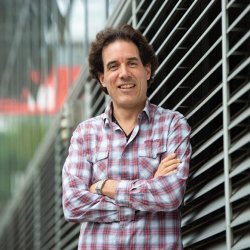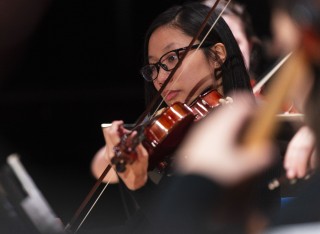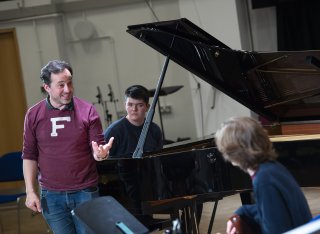
Dr Tom Armstrong
About
Biography
Tom Armstrong studied composition with George Nicholson and, at York University, Roger Marsh. Performers of his music include the Fidelio Trio, Jane Chapman, Jakob Fichert, Simon Desbruslais, Notes Inégales, Gemini, Madeleine Shapiro and the BBC Philharmonic. His music has been performed in Europe, China, Australia and the US.
Tom frequently collaborates with other art forms (dance in particular) and ‘through the score’ using loosely determined notation as in Shadow Variations (2019) for ukulele ensemble. Tom’s CD Dance Maze (Resonus Classics 2018) presents pieces in different versions involving alternative approaches to the same materials that highlight his interest in the creative potential of musical recycling. Tom frequently reworks other composers’ music as current collaborations attest: a set of Bartók arrangements for the Hungarian guitarist Katalin Koltai, a programme of re-imagined ‘classics’ for Trifarious and a song project with the pianist and composer Nathan Williamson. Damascene Redux (2014), a reworking of Tom’s Damascene Portrait (2003), was released on the CD Late Music by the Delta Saxophone Quartet in 2023.
Tom is a Senior Lecturer in Music at the University of Surrey. His practice-led research is published by Palgrave Macmillan, appears in the Journal of the Royal Musical Association and has been funded by the AHRC.
February 2024
Areas of specialism
University roles and responsibilities
- Director of Learning and Teaching, Department of Music and Media
- Senior Personal Tutor, Department of Music and Media
Music on CD
My diptych Opened Spaces to original texts by Jim Morris for baritone and piano is available on Meridian Records.
Much of my work on revision and reworking is available on the CD Dance Maze released on Resonus Classics.
Music Online
Spotify streams the CDs described above
The British Music Collection (formerly at the BMIC, now hosted by the University of Huddersfield) have digitised copies of my scores from 1992-2005.
ResearchResearch interests
My research is led by my practice as a composer. Since around 2015 my music and research have centred on processes of musical borrowing. Sometimes I make self-borrowings in the form of revisions and reworkings of extant works so that (in the case of reworkings) they may present several different versions of the same materials. On other occasions (in pieces like JPR, Tänze or Berceuse 1917) I am borrowing music by other composers. In-progress projects exist in the overlap between composing and arranging; I am interested in gentle and yet evident interventions in pre-existing material (now usually by others). I am also interested in overlaps between composing and programming - compositional curation if you will. In the process of assembling a programme as a composer I am working with much larger scale materials, e.g. whole pieces or sections of pieces by other composers. My interest in indeterminacy continues to inform my work depending upon the musical backgrounds and expertise of performers I work with. Collaboration now tends to be a 'given' in my work although to varying degrees of intensity within each project. As an artist in academia, although I now have several academic publications to my name, I am interested in making a much stronger case for the artwork as research, not by insisting it ‘speak for itself’ but by ensuring that writing is tightly focussed on the research dimensions of the work and is sufficient enough to bring those out and no more.
Research interests
My research is led by my practice as a composer. Since around 2015 my music and research have centred on processes of musical borrowing. Sometimes I make self-borrowings in the form of revisions and reworkings of extant works so that (in the case of reworkings) they may present several different versions of the same materials. On other occasions (in pieces like JPR, Tänze or Berceuse 1917) I am borrowing music by other composers. In-progress projects exist in the overlap between composing and arranging; I am interested in gentle and yet evident interventions in pre-existing material (now usually by others). I am also interested in overlaps between composing and programming - compositional curation if you will. In the process of assembling a programme as a composer I am working with much larger scale materials, e.g. whole pieces or sections of pieces by other composers. My interest in indeterminacy continues to inform my work depending upon the musical backgrounds and expertise of performers I work with. Collaboration now tends to be a 'given' in my work although to varying degrees of intensity within each project. As an artist in academia, although I now have several academic publications to my name, I am interested in making a much stronger case for the artwork as research, not by insisting it ‘speak for itself’ but by ensuring that writing is tightly focussed on the research dimensions of the work and is sufficient enough to bring those out and no more.
Supervision
Postgraduate research supervision
Ruth Hansford What does it Mean to have a Musician's Ear? Listening to Musicians. A PhD researching ways in which orchestral musicians cope with hearing loss.
Paul Newbold Musical Refractions of the Mundane: the Transformation of Time and Place. A practice-led PhD exploring the creation of a musical language based on time- and location-specific data.
Ornella Strologo Improvising Voices: Practices, Techniques and Wellbeing in Free Vocal Improvisation. A practice-led PhD investigating the application of 'free voice' improvisational techniques in a community music workshop setting.
Completed postgraduate research projects I have supervised
Philip Singleton (2016) Spectralism Today: a Survey of the Consequences for Contemporary Composition of the French Spectral School of the 1970s and 1980s.
Spyridon Tsilimparis (2016) An Analysis of Luciano Berio's 'Sequenza VI' for Viola (1967) and a Folio of Nine Compositions.
Neil Carey (2018) Intuition and Reason: Decision-Making in Compositional Processes.
Octavius Longcroft-Wheaton (2020) The Stylistic Development of the Grateful Dead: 1965-1973. This was supervised jointly with Chris Wiley.
Steve Tromans (2020) Rhythmicity and the Deleuzian: Investigating a Notion of the Musical-Philosophical in Practice as Research. This was supervised jointly with Laura Cull.
Teaching
First year undergraduate: Module Leader for Pathways in Musicianship A and B.
Final year undergraduate: Module Leader for Composition 3A and 3B; supervision of Individual Project work mainly related to composition and performance.
Postgraduate taught: Module Leader for Research Training for Practitioners A and B.
All years/levels: performance seminars, convenor of Music Professional Practice (careers) seminars, occasional coaching, ensemble direction and accompanying.
Publications
In this paper I discuss a series of my pieces that rework historical materials using various erasing procedures. My focus will be on the latest of these, The Gramophone Played, completed earlier this year, which is different in several respects: it was composed collaboratively, with the cellist Madeleine Shapiro, and it uses historical recordings rather than scores as its main sources. These features, alongside texts spoken by Madeleine and myself, result in a piece of many voices; my paper will consider some of the theoretical implications of this, drawing contrasts with earlier pieces in which I have argued that my composer’s ‘voice’ has been in abeyance.
The Gramophone Played for cello, spoken word and fixed media electronics was inspired by the works of the British poet Edward Thomas (1878-1917) and by the writings about him in Robert Macfarlane’s book ‘The Old Ways’, in particular a fictionalised account of his final months at the Western Front where Thomas, serving as an artillery officer, was killed during the battle of Arras. Macfarlane writes of the gramophone records heard in the officers’ billets and we have woven some of these, alongside two of Thomas’ poems, into the fabric of the piece. The cello part is improvised in response to them using melodic skeletons from the songs. The recordings and the singers who perform on them - ‘Wait Till I’m As Old As Father’ (Billy Williams), ‘D’Ye Ken John Peel’ (Peter Dawson), ‘On The Banks of Allan Water’ (Adelina Patti) - are auditory windows onto a time long distant; these and Madeleine’s improvised responses lend our piece something of the character of a threnody so if our piece has a message it is a decidedly anti-war one - a threnody for Edward Thomas himself and for the victims of all wars, both military and civilian.
Brontë Antiphons was commissioned by Late Music York for the Elysian Singers.
It is a setting of Emily Brontë’s poem No Coward Soul is Mine and is designed, as
specified by the commission, to be paired with David Power’s setting of the same text.
I have responded to this request in two ways: David’s striking setting of the first line has
been incorporated into my piece and I have set the same stanzas as David in addition to
the remaining three that he omits. The nature of the ‘missing’ stanzas determined the
materials used in my setting; they express an exalted religious quality with references to
‘God’, ‘spirit’, ‘his might’, ‘Being and Breath’. To reflect this I have drawn on antiphons
(musical prefaces to the reciting of psalms) from the Whit Sunday second Vespers service
that occurs at the start of the season of Pentecost; music associated with the entry of the
Holy Spirit into the disciples seemed of a piece with Brontë’s fervent language in her
second, fifth and final stanzas. I have used the six antiphons very directly, interfering as
little as possible with their melodic designs and keeping to the original modes as printed in
the Liber usualis (the book of chants and texts used in Catholic church services). The
antiphons are presented variously as single lines, superimposed on one another, or in self
harmonised versions where notes are sustained so that they overlap to form chords. My
setting begins with double versions of stanzas one, three, four and six, alternating music
based on David’s setting with antiphon-based melodies. I then move on to the remaining
stanzas using purely antiphon-based material. Although I am not a Christian it has been a
moving experience engaging with these millennia old melodies; I have sensed some of
their power and newly appreciated the significance they have for many.
Berceuse 1917 uses isolated words taken from the penultimate chapter of Robert Macfarlane’s The Old Ways, a fictionalised recreation of the final months of the poet Edward Thomas’ life as a WW1 artillery officer. Macfarlane includes a refrain listing music playing on the gramophone in Thomas’ various billets - Chopin’s Berceuse is one of the pieces mentioned. Both voice and piano are derived from the Chopin, the latter given tiny slivers of music from each bar. The parts are arrayed in 10x10 grids that the performers can read through in any direction, coordinating loosely with each other.
These four transcriptions are taken from a larger work, Bartókiana, for the newly-developed ‘Koltai guitar’ with single-string adjustable capos. The ability to alter the open string notes of the instrument creates a very flexible medium that can be adapted to Béla Bartók’s unmistakable musical language with its chromatic and often highly dissonant harmony. In any process of transcription the notion of remaining ‘faithful’ to the original is difficult, if not unhelpful, to maintain. Over the course of these four pieces Bartók’s originals, whilst always recognisable, move further from their familiar forms. The Flute of the Slovak Shepherd, from For Children, is an attempt at the closest guitar transcription possible; Arab Song, from 44 Duos for Two Violins, introduces passages of silence partly to facilitate the re-setting of capos but also as a deliberate challenge to the whirling energy of the piece; Romanian Christmas Carols is an abridgement of Bartók’s medley of piano arrangements in which each carol is played once only; finally, in the eight Improvisations on Hungarian Peasant Songs only the atonal interludes are included in my transcription and silence features here to a greater extent than previously. The decision to transcribe Bartók’s folk arrangements was made to try and mirror his polyglot ideals in our own increasingly troubled times (perhaps not yet as troubled and war-torn as Bartók’s own but still with disturbing and tragic similarities). For Bartók, folk music was not only a means of studying cultures in isolation but investigating the productive way cultures interact to produce new musical hybrids; I see such thinking as an antidote of sorts to the increasingly aggressive and paranoid separatism and individualism characterising much of the world today.
This lecture-recital* presents a case study of a ten year musical partnership between composer Tom Armstrong and cellist Madeleine Shapiro. Our aim is to reveal what happens when a long-standing composer/performer relationship is developed, and bears creative fruit, entirely online. Through this study we determine how closely a technologically meditated artistic partnership is able to approach “collective and communal music making” as well as revealing the effects of such mediation on the resulting music and its creation.
Now in its 11th year our musical partnership began in late 2012 when we met at a conference in Coventry; this has been our only face-to-face meeting to date - we have subsequently communicated entirely via email and, since September 2018, Skype/Zoom. The musical outcome of our partnership is The Gramophone Played (2018-21/23) for cello and fixed media electronics, to be played in the latter half of our presentation.
The compositional process and music of The Gramophone Played clearly show traces of collaboration - evidence of mutuality and reciprocity, fluidity of composer/performer roles and joint working. By necessity there were also clearly distributed features - little intervention in each others’ materials, no shared listening back, no workshopping phase. This ‘together apartness’ was disciplined and made fruitful (communal?) through the technological medium of the DAW, facilitating the assemblage and subsequent micro-editing of our respective contributions.
During our lecture-recital we will highlight and explain key points within these collaborative and distributed creative processes. We will also draw on evidence from 2012-18 during which we were engaged in the equally creative work needed to initiate and sustain our relationship through gaining mutual respect, trust and, finally, friendship. ~.
*Please note that the performance will be presented as a high quality audio recording.
This chapter examines my collaboration with trumpeter Simon Desbruslais on a new piece for trumpet and string quartet situated within the worlds of artistic practice and academic research. The methodology used is a broadly qualitative one with a range of data from rehearsal recordings to retrospective accounts underpinning an interpretation of why the collaboration unfolded as it did. My interpretation revolves around the theme of tension existing in the artistic domain (between determinacy and indeterminacy) and between the artistic and academic research domains in attitudes to research questions and methods. I show how the collaboration was affected by such tensions and the differing degrees to which it was able to resolve them. I conclude with a discussion of the need for productive tension and the role of collaboration in maintaining the integrity of the practitioner-researcher role and realising its potential in both areas.

